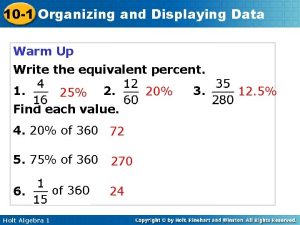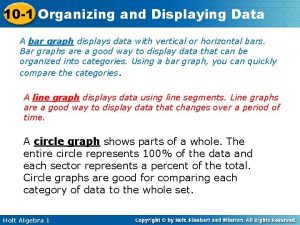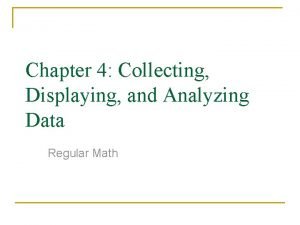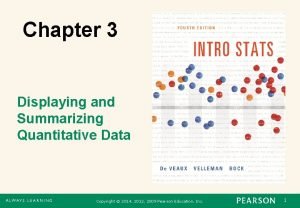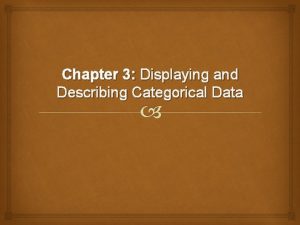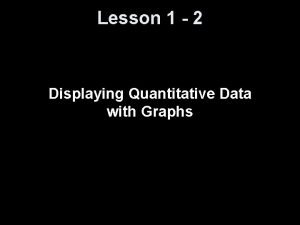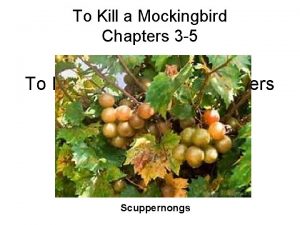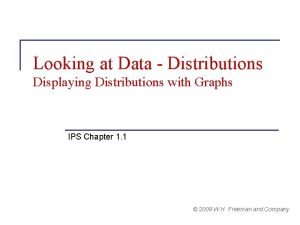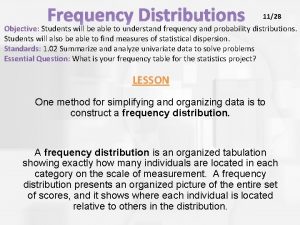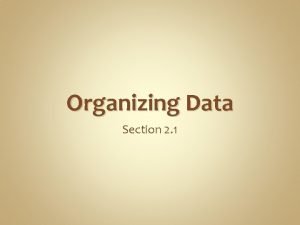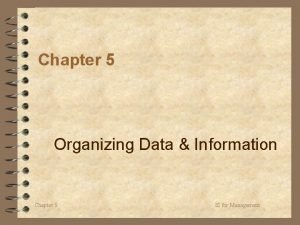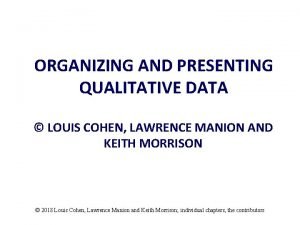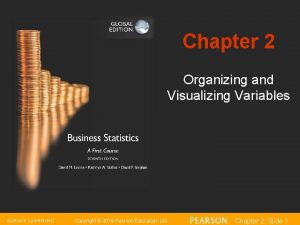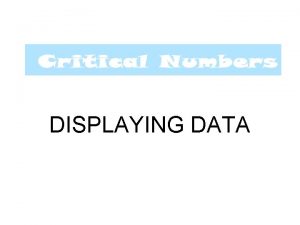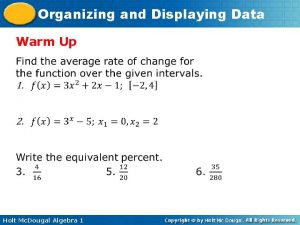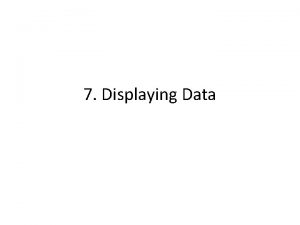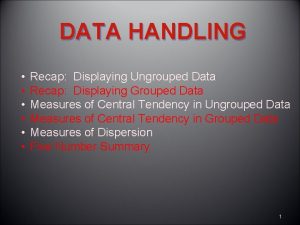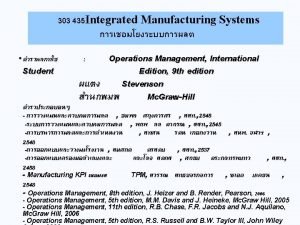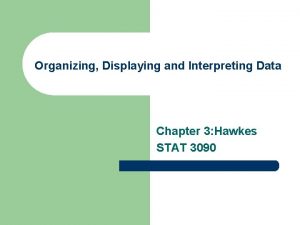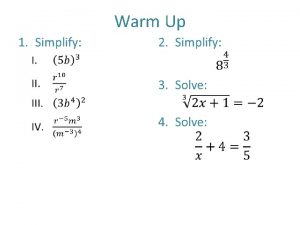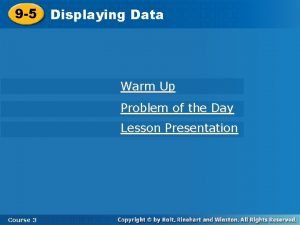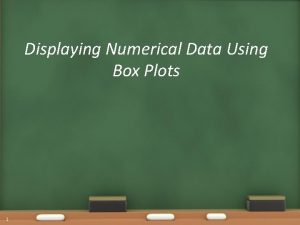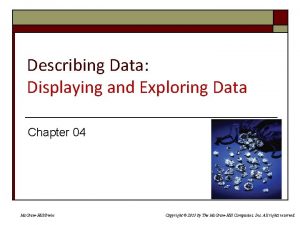10 1 Organizing and Displaying Data Warm Up



































- Slides: 35

10 -1 Organizing and Displaying Data Warm Up Write the equivalent percent. 1. 2. Find each value. 4. 20% of 360 5. 75% of 360 6. Holt Mc. Dougal Algebra 1 3.

10 -1 Organizing and Displaying Data Vocabulary bar graph line graph circle graph stem and leaf plot frequency table histogram Holt Mc. Dougal Algebra 1

10 -1 Organizing and Displaying Data Bar graphs, line graphs, and circle graphs can be used to present data in a visual way. A bar graph displays data with vertical or horizontal bars. Bar graphs are a good way to display data that can be organized into categories. Using a bar graph, you can quickly compare the categories. Holt Mc. Dougal Algebra 1

10 -1 Organizing and Displaying Data Example 1: Reading and Interpreting Bar Graphs Use the graph to answer each question. A. Which casserole was ordered the most? B. About how many total orders were placed? C. About how many more tuna noodle casseroles were ordered than king ranch casseroles? D. About what percent of the total orders were for baked ziti? Holt Mc. Dougal Algebra 1

10 -1 Organizing and Displaying Data a. Which ingredient contains the least amount of fat? bread b. Which ingredients contain at least 8 grams of fat? cheese and mayonnaise Holt Mc. Dougal Algebra 1

10 -1 Organizing and Displaying Data A double-bar graph can be used to compare two data sets. A double-bar graph has a key to distinguish between the two sets of data. Holt Mc. Dougal Algebra 1

10 -1 Organizing and Displaying Data Example 2: Reading and Interpreting Double Bar Graphs A. Which feature received the same satisfaction rating for each SUV? Cargo B. Which SUV received a better rating for mileage? SUV Y Holt Mc. Dougal Algebra 1

10 -1 Organizing and Displaying Data Check It Out! Example 2 Use the graph to determine which years had the same average basketball attendance. What was the average attendance for those years? Holt Mc. Dougal Algebra 1

10 -1 Organizing and Displaying Data A line graph displays data using line segments. Line graphs are a good way to display data that changes over a period of time. Holt Mc. Dougal Algebra 1

10 -1 Organizing and Displaying Data A. At what time was the humidity the lowest? B. During which 4 -hour time period did the humidity increase the most? Holt Mc. Dougal Algebra 1

10 -1 Organizing and Displaying Data Check It Out! Example 3 Use the graph to estimate the difference in temperature between 4: 00 A. M. and noon. Holt Mc. Dougal Algebra 1

10 -1 Organizing and Displaying Data A double-line graph can be used to compare how two related data sets change over time. A doubleline graph has a key to distinguish between the two sets of data. Holt Mc. Dougal Algebra 1

10 -1 Organizing and Displaying Data Example 4: Reading and Interpreting Double-Line Graphs A. In which month did station A charge more than station B? May B. During which month(s) did the stations charge the same for gasoline? April and July Holt Mc. Dougal Algebra 1

10 -1 Organizing and Displaying Data Check It Out! Example 4 Use the graph to describe the general trend of the data. Holt Mc. Dougal Algebra 1

10 -1 Organizing and Displaying Data A circle graph shows parts of a whole. The entire circle represents 100% of the data and each sector represents a percent of the total. Circle graphs are good for comparing each category of data to the whole set. Holt Mc. Dougal Algebra 1

10 -1 Organizing and Displaying Data Example 5: Reading and Interpreting Circle Graphs 12. 5% 50% 25% Which ingredients are present in equal amounts? Lemon sherbet and pineapple juice. Holt Mc. Dougal Algebra 1

10 -1 Organizing and Displaying Data Check It Out! Example 5 Use the graph to determine what percent of the fruit salad is cantaloupe. Holt Mc. Dougal Algebra 1

10 -1 Organizing and Displaying Data Example 6 A: Choosing and Creating an Appropriate Display Use the given data to make a graph. Explain why you chose that type of graph. Flowers in an Arrangement Holt Mc. Dougal Algebra 1

10 -1 Organizing and Displaying Data Example 6 B: Choosing and Creating an Appropriate Display Use the given data to make a graph. Explain why you choose that type of graph. Degrees Held by Faculty Holt Mc. Dougal Algebra 1

10 -1 Organizing and Displaying Data Example 6 C: Choosing and Creating an Appropriate Display Use the given data to make a graph. Explain why you chose that type of graph. County Farms 248 Holt Mc. Dougal Algebra 1

10 -1 Organizing and Displaying Data Holt Mc. Dougal Algebra 1

10 -1 Organizing and Displaying Data Holt Mc. Dougal Algebra 1

10 -1 Organizing and Displaying Data Holt Mc. Dougal Algebra 1

10 -1 Organizing and Displaying Data Holt Mc. Dougal Algebra 1

10 -1 Organizing and Displaying Data Holt Mc. Dougal Algebra 1

10 -1 Organizing and Displaying Data Holt Mc. Dougal Algebra 1

10 -1 Organizing and Displaying Data Example 1 A: Making a Stem-and-Leaf Plot The numbers of defective widgets in batches of 1000 are given below. Use the data to make a stem-and-leaf plot. 14, 12, 8, 9, 13, 20, 15, 9, 21, 8, 13, 19 Number of Defective Widgets per Batch Stem Leaves Holt Mc. Dougal Algebra 1

10 -1 Organizing and Displaying Data Example 1 B: Making a Stem-and-Leaf Plot The season’s scores for the football teams going to the state championship are given below. Use the data to make a back-to-back stem-and-leaf plot. Team A: 65, 42, 56, 49, 58, 42, 61, 55, 45, 72 Team B: 57, 60, 48, 49, 52, 61, 58, 37, 63, 48 Holt Mc. Dougal Algebra 1

10 -1 Organizing and Displaying Data The frequency of a data value is the number of times it occurs. A frequency table shows the frequency of each data value. If the data is divided into intervals, the table shows the frequency of each interval. Holt Mc. Dougal Algebra 1

10 -1 Organizing and Displaying Data Example 2: Making a Frequency Table The numbers of students enrolled in Western Civilization classes at a university are given below. Use the data to make a frequency table with intervals. 12, 22, 18, 9, 25, 31, 28, 19, 22, 27, 32, 14 Holt Mc. Dougal Algebra 1

10 -1 Organizing and Displaying Data Example 2 Continued Step 2 Divide the data into equal intervals. For this data set, use an interval of 10. Enrollment in Western Civilization Classes Number Frequency Enrolled 1 – 10 11 – 20 21 – 30 31 – 40 Holt Mc. Dougal Algebra 1 1 4 5 2

10 -1 Organizing and Displaying Data Check It Out! Example 2 The number of days of Maria’s last 15 vacations are listed below. Use the data to make a frequency table with intervals. 4, 8, 6, 7, 5, 4, 10, 6, 7, 14, 12, 8, 10, 15, 12 Holt Mc. Dougal Algebra 1

10 -1 Organizing and Displaying Data A histogram is a bar graph used to display the frequency of data divided into equal intervals. The bars must be of equal width and should touch, but not overlap. Holt Mc. Dougal Algebra 1

10 -1 Organizing and Displaying Data Example 3: Making a Histogram Use the frequency table in Example 2 to make a histogram. Step 1 Use the scale and interval from the frequency table. Enrollment in Western Civilization Classes Number Frequency Enrolled Step 2 Draw a bar for the number of classes in each interval. 1 – 10 11 – 20 21 – 30 31 – 40 Holt Mc. Dougal Algebra 1 1 4 5 2

10 -1 Organizing and Displaying Data Check It Out! Example 3 Make a histogram for the number of days of Maria’s last 15 vacations. 4, 8, 6, 7, 5, 4, 10, 6, 7, 14, 12, 8, 10, 15, 12 Holt Mc. Dougal Algebra 1
 Organizing and displaying data
Organizing and displaying data Organizing and displaying data
Organizing and displaying data Data preparing exploring examining and displaying
Data preparing exploring examining and displaying Collecting and displaying data
Collecting and displaying data Summarizing quantitative data
Summarizing quantitative data Categorical data displays
Categorical data displays Uniform bell-shaped skewed-right skewed-left
Uniform bell-shaped skewed-right skewed-left Displaying quantitative data
Displaying quantitative data Displaying data from multiple tables
Displaying data from multiple tables Tacit to kill a mockingbird
Tacit to kill a mockingbird Organizing and graphing data
Organizing and graphing data How to display petit fours
How to display petit fours Displaying distributions with graphs
Displaying distributions with graphs Fonts in pygame
Fonts in pygame Organizing data in a traditional file environment
Organizing data in a traditional file environment Organizing data using frequency distribution
Organizing data using frequency distribution Organizing qualitative data
Organizing qualitative data Organizing data definition
Organizing data definition Organizing qualitative data
Organizing qualitative data Presenting qualitative data
Presenting qualitative data Planning and staffing
Planning and staffing Planning directing controlling organizing
Planning directing controlling organizing Organizing students to practice and deepen knowledge
Organizing students to practice and deepen knowledge Example of analysis paragraph
Example of analysis paragraph Who are managers
Who are managers Vocabulary and organizing of text
Vocabulary and organizing of text Organizing lifes diversity
Organizing lifes diversity Marzano element 15
Marzano element 15 Manuscript for speech
Manuscript for speech Outline of entertainment speech
Outline of entertainment speech Time management is the process of organizing and planning
Time management is the process of organizing and planning Selecting organizing and interpreting information
Selecting organizing and interpreting information Fungsi manajemen coordinating
Fungsi manajemen coordinating 8+8+8 time management
8+8+8 time management Organizing and outlining your speech
Organizing and outlining your speech Organizing and visualizing variables
Organizing and visualizing variables
